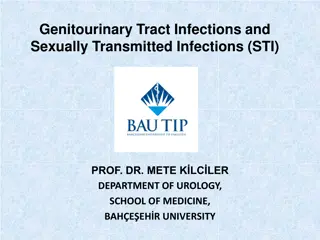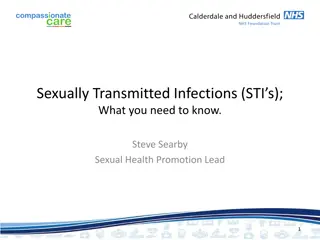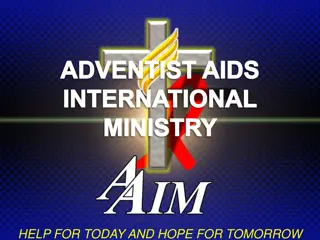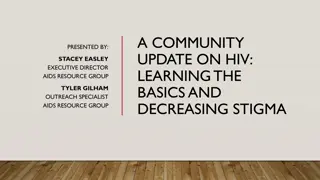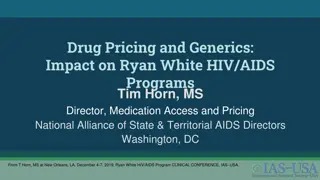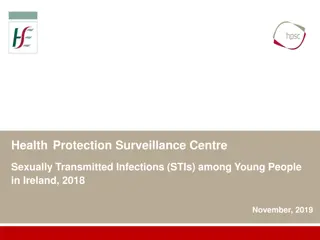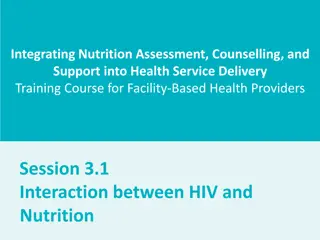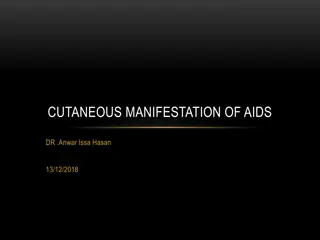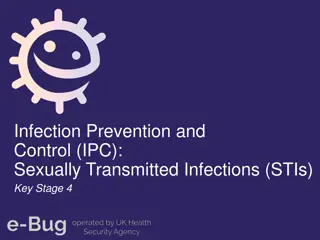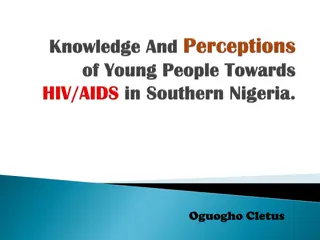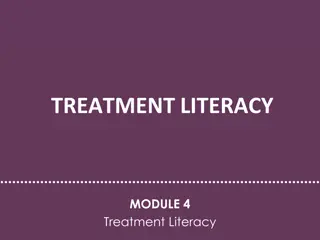Understanding STIs and HIV/AIDS Among American Indian Women
Learn about various sexually transmitted infections (STIs), how they are contracted, and the importance of protection and testing. Understand the impact of STIs on American Indian women locally and nationally, including HIV, Herpes, HPV, Chlamydia, Gonorrhea, and Syphilis. Explore the progression from HIV to AIDS, symptoms, and the significance of early detection and treatment.
Download Presentation

Please find below an Image/Link to download the presentation.
The content on the website is provided AS IS for your information and personal use only. It may not be sold, licensed, or shared on other websites without obtaining consent from the author. Download presentation by click this link. If you encounter any issues during the download, it is possible that the publisher has removed the file from their server.
E N D
Presentation Transcript
To learn about different types of sexually transmitted infections (STIs) To understand how STIs are contracted To learn how to protect ourselves against infection To understand how STIs affect American Indian women locally and nationally To realize the importance of getting tested
Transmitted through sexual contact- anal, oral, or vaginal sex- with someone who has an STI Some (herpes & HPV) are spread by skin-to-skin contact Many do not show symptoms for a long time Can still be harmful and passed on during sex Some can be cured, all can be treated
HIV Herpes HPV Chlamydia Gonorrhea Syphilis
Human: Infects human beings Immunodeficiency: Decreases or weakens the body s ability to fight off infections and illnesses Virus: A germ having the ability to multiply only inside a living cell
Acquired: To come into possession of something new Immune Deficiency: Decrease or weakness in the body s ability to fight off infections and illnesses Syndrome: A group of signs and symptoms that occur together and characterize a particular abnormality AIDS is the final stage of the disease caused by HIV infection.
HIV is the virus that causes AIDS Not everyone who is infected with HIV has AIDS Everyone with AIDS is infected with HIV AIDS is result of the progression of HIV Infection Anyone infected with HIV, although healthy, can still transmit the virus to another person HIV AIDS
Acute State Flu-like symptoms- 1 to 3 weeks Asymptomatic period No physical symptoms- 8 to 11 years HIV Illness Night sweats, fatigue, diarrhea, fever, yeast infections, swollen lymph nodes AIDS Opportunistic Infections- CD4 <200
CD4 T Cells Latent period - no symptoms Infection Start getting sick often Body cannot fight infections Flu-like symptoms possible 0 3 6 9 12 1 2 3 4 5 6 7 8 9 10 11 Weeks Years
Body fluids Blood Semen Vaginal Fluids Breast milk (of an HIV infected person) HIV is NOT NOT transmitted in: urine, sweat, tears, or saliva.
Having unprotected anal, oral, or vaginal sex with an HIV infected person Sharing needles or syringes An infected mother to child- before, during, or after birth Occupational exposures (health care)
Casual contact Kissing Sharing eating utensils/drinking glasses Insect bites Using the same restroom Water fountains Donating blood
May not show symptoms, but can still be spread Can cause damage to female reproductive system if untreated Can be cured with the right treatment May begin having sex again one week AFTER completed entire course of treatment
Women with symptoms may notice: An abnormal vaginal discharge A burning sensation when urinating Men with symptoms may notice: A discharge from their penis A burning sensation when urinating Pain and swelling in one or both testicles (although this is less common)
May not show symptoms (especially in women) Can cause infections in the genitals, rectum, and throat Can cause damage to reproductive system if untreated Can be cured with the right treatment May begin having sex again one week AFTER completed entire course of treatment
Women with symptoms may notice: Painful or burning sensation when urinating Increased vaginal discharge Vaginal bleeding between periods Men with symptoms may notice: A burning sensation when urinating A white, yellow, or green discharge from the penis Painful or swollen testicles (although this is less common
Spread by direct contact with a syphilis sore during vaginal, anal, or oral sex Has many possible symptoms Initial sore after infection often called the great imitator because it can be confused with other diseases (or an ingrown hair, zipper cut, etc.) Can be cured
Primary Stage: Usually a single sore (firm, round, painless), but can be multiple, that will heal on its own in 3-6 weeks Secondary Stage: Skin rashes and/or sores in mouth, vagina, or anus May have fever, swollen lymph glands, patchy hair loss, weight loss, muscle aches, and fatigue Latent Stage: Symptoms disappear, but you are still infected and infectious. Late Stage: Difficulty coordinating your muscle movements, paralysis, numbness, blindness, dementia, internal organ damage, and death
Outbreaks can be severe in people with suppressed immune systems (like HIV+ people) Can spread to other body parts, such as eye Cannot be cured Can be passed from mother to baby during pregnancy Can cause potentially deadly neonatal herpes
May appear as one or more blisters on or around the genitals, rectum or mouth, which will break and leave painful sores May also have flu-like symptoms during first outbreak
Most common STI (nearly all sexually active men and women get it at some point) Some types can cause health problems, i.e. genital warts, cancer Otherwise, may not show symptoms No test to know HPV status Cannot be cured or treated, though warts and cancers can be detected and treated Vaccine is available to prevent most common types
Compared to the state population in 2014, American Indians in Arizona were diagnosed with: Chlamydia twice as often Gonorrhea twice as often HIV 1.4 times as often
For every 100,000 American Indians in Arizona in 2014: 1,088 were diagnosed with chlamydia 229 were diagnosed with gonorrhea 17 were diagnosed with early syphilis 10 were diagnosed with HIV
Having anal, vaginal, or oral sex without a condom Having multiple sex partners Having anonymous sex partners Having sex while under the influence of drugs or alcohol (can lower inhibitions and result in greater sexual risk taking)
A Abstain from sex, drugs, and alcohol B Be faithful, or postpone sexual activity C Correct and consistent barrier (condom or dental dam) & water-based lubrication use D Do not share needles or syringes





